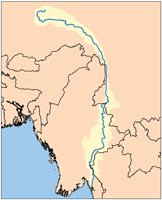
Spirit Cave, Thailand
Encyclopedia

Amphoe Pang Mapha
Pang Mapha is the northernmost district of Mae Hong Son Province, northern Thailand.-Etymology:In the Shan language, Mapha or Makpha means lime and Pang means hill, so a translation into English might be Lime Hill....
, Mae Hong Son Province
Mae Hong Son Province
Most of the areas of Mae Hong Son Province are complex mountain ranges and likely still pristine virgin forest. Of the approximately 6,976,650 rai of national forest reserves, 88.02% is thought to be pristine virgin forest...
, Northwestern Thailand
Thailand
Thailand , officially the Kingdom of Thailand , formerly known as Siam , is a country located at the centre of the Indochina peninsula and Southeast Asia. It is bordered to the north by Burma and Laos, to the east by Laos and Cambodia, to the south by the Gulf of Thailand and Malaysia, and to the...
. It was occupied from about 9000 until 5500 BC by Hoabinhian
Hoabinhian
The term Hoabinhian was first used by French archaeologists working in Northern Vietnam to describe Holocene period archaeological assemblages excavated from rock shelters. It has become a common term in the English based literature to describe stone artifact assemblages in Southeast Asia that...
hunters and gatherers.
Location
The site is located at an elevation of 650 m. above sea level on a hillside overlooking a small stream. The Salween RiverSalween River
The Salween is a river, about long, that flows from the Tibetan Plateau into the Andaman Sea in Southeast Asia. It drains a narrow and mountainous watershed of that extends into the countries China, Burma and Thailand. Steep canyon walls line the swift, powerful and undammed Salween, one of the...
, one of Southeast Asia's longest rivers, is less than 50 km (31.1 mi)to the north. It was excavated in the mid 1960s by Chester Gorman
Chester Gorman
Chester F. Gorman was an American anthropologist and archaeologist.Born in Oakland, California, he grew up on his parent's dairy farm in Elk Grove. He studied at the Sacramento State University and the University of Hawaii, where he also got his MA and his PhD.Chester Gorman worked mostly in...
. Two other significant sites nearby are the Banyan Valley Cave and the Steep Cliff Cave.
New Stone Age
The site is dated in the NeolithicNeolithic
The Neolithic Age, Era, or Period, or New Stone Age, was a period in the development of human technology, beginning about 9500 BC in some parts of the Middle East, and later in other parts of the world. It is traditionally considered as the last part of the Stone Age...
or New Stone Age, a period in the development of human technology that is traditionally the last part of the Stone Age
Stone Age
The Stone Age is a broad prehistoric period, lasting about 2.5 million years , during which humans and their predecessor species in the genus Homo, as well as the earlier partly contemporary genera Australopithecus and Paranthropus, widely used exclusively stone as their hard material in the...
. Beginning with the rise of farming, which produced the "Neolithic Revolution
Neolithic Revolution
The Neolithic Revolution was the first agricultural revolution. It was the transition from hunting and gathering to agriculture and settlement. Archaeological data indicates that various forms of plants and animal domestication evolved independently in 6 separate locations worldwide circa...
" and ending when metal tools became widespread in the Copper Age
Copper Age
The Chalcolithic |stone]]") period or Copper Age, also known as the Eneolithic/Æneolithic , is a phase of the Bronze Age in which the addition of tin to copper to form bronze during smelting remained yet unknown by the metallurgists of the times...
(chalcolithic) or Bronze Age
Bronze Age
The Bronze Age is a period characterized by the use of copper and its alloy bronze as the chief hard materials in the manufacture of some implements and weapons. Chronologically, it stands between the Stone Age and Iron Age...
Plant domestication

In 1972 W.G. Solheim, as the director of the project of which Spirit Cave was part, published an article in Scientific American discussing the finds from Spirit Cave. While Solheim noted that the specimens may 'merely be wild species gathered from the surrounding countryside', he claimed that the inhabitants at Spirit Cave had 'an advanced knowledge of horticulture
Horticulture
Horticulture is the industry and science of plant cultivation including the process of preparing soil for the planting of seeds, tubers, or cuttings. Horticulturists work and conduct research in the disciplines of plant propagation and cultivation, crop production, plant breeding and genetic...
'. Solheim's chronological chart suggests that 'incipient agriculture
Agriculture
Agriculture is the cultivation of animals, plants, fungi and other life forms for food, fiber, and other products used to sustain life. Agriculture was the key implement in the rise of sedentary human civilization, whereby farming of domesticated species created food surpluses that nurtured the...
' began at about 20,000 B.C. in southeast Asia. He also suggests that ceramic technology was invented at 13,000 B.C. although Spirit Cave does not have ceramics until after 6800 B.C.
Although Solheim concludes that his reconstruction is 'largely hypothetical
Hypothesis
A hypothesis is a proposed explanation for a phenomenon. The term derives from the Greek, ὑποτιθέναι – hypotithenai meaning "to put under" or "to suppose". For a hypothesis to be put forward as a scientific hypothesis, the scientific method requires that one can test it...
', his overstatement of the results of Gorman's excavation has led to inflated claims of Hoabinhian agriculture. These claims have detracted from the significance of Spirit Cave as a site with well-preserved evidence of human subsistence and palaeoenvironmental conditions during the Hoabinhian.

